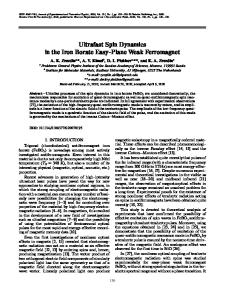Polariton dynamics of a bounded weak ferromagnet in an external dc electric field tangential to the interface
- PDF / 261,225 Bytes
- 10 Pages / 612 x 792 pts (letter) Page_size
- 24 Downloads / 366 Views
ICAL PROPERTIES OF CRYSTALS
Polariton Dynamics of a Bounded Weak Ferromagnet in an External dc Electric Field Tangential to the Interface D. V. Kulagin, A. S. Savchenko, and S. V. Tarasenko Donetsk Institute for Physics and Engineering, National Academy of Sciences of Ukraine, Rosa Luxemburg st. 72, Donetsk, 83114 Ukraine e-mail: [email protected] Received August 30, 2007
Abstract—Using the example of a semibounded easy-plane weakly ferromagnetic crystal, magnetized tangentially to its surface, the conditions have been determined under which, with the application of an external dc electric field along the easy-magnetization axis, a number of anomalies arise at the transmission and localization of OA and TM electromagnetic waves through the interface between a nonmagnetic dielectric and a weak ferromagnet due to quadratic magneto-optical interaction. PACS numbers: 41.20.-q, 03.65.Ge DOI: 10.1134/S1063774508060217
INTRODUCTION As was shown in [1–5], near the interface between an easy-axis antiferromagnet (EA AFM) and vacuum, an external dc electric field may lead not only to the transformation of the spectrum of surface magnetic OA polaritons but also to the formation of a new type of surface magnetic TM polaritons near the surface of the centrosymmetric antiferromagnet. In this case, the quadratic magneto-optical interaction was thought to be the physical mechanism responsible for this effect; for the two-sublattice model of EA AFM (M1, 2 are the magnetizations of the sublattices; |M1| = |M2 | = M0) in the collinear phase, it can be presented as [6, 7] F mo = – λ αβγδ l α l β E γ E δ /8π,
(1)
where l = (M1 – M2)/2M0 is the antiferromagnetism vector. It follows from [1–5] that the relative orientation of the applied electric field and the normal to the interface between the magnetic and nonmagnetic media plays an important role in the formation and propagation of surface magnetic polaritons. Undoubtedly, the fact that such a mechanism of magnetoelectric interaction can exist in a crystal of any symmetry is also important. However, until now, analysis of the electric field effect on the polariton dynamics of bounded antiferromagnetic crystals was performed only for compensated antiferromagnets. In particular, for the two-sublattice model of a antiferromagnet, it corresponds to zero fer-
romagnetism vector (m = (M1 + M2)/2M0 in the ground state. At the same time, analyzing the role of the quadratic magneto-optical interaction in the polariton dynamics of an uncompensated antiferromagnet placed in an external dc electric field is also of undoubted interest. In particular, this is due to the existence of a number of high-quality exchange collinear antiferromagnetic structures having a nonzero ferromagnetic moment. The magneto-optical properties of such structures in the absence of an external electric field were studied in detail in [8]. The purpose of this study is to determine the conditions under which one can deliberately change the character of polariton dynamics of a bounded easyplane weakly ferrom
Data Loading...











